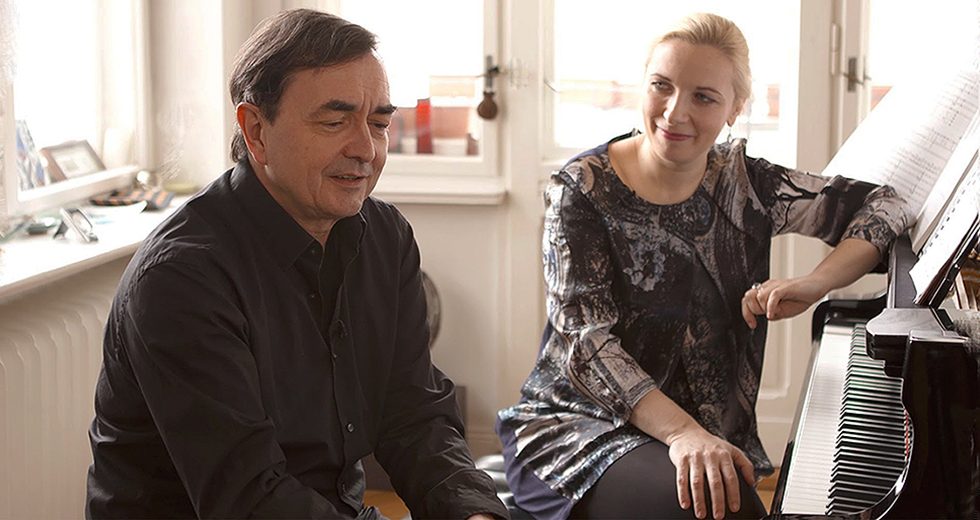
A solo piano recital can be one of the most compelling events in classical music. But pair two pianists, each with his or her own musical styles and predilections, at the keyboards of interlocking nine-foot concert grands, and the results can be even more electric. That’s why piano duos have been popular with composers and audiences for centuries.
Tamara Stefanovich and Pierre-Laurent Aimard, who perform in the opening concert Oct. 28 of the 2018-19 SCP Piano Series, are longtime collaborators. She began studying what she called the “classics of contemporary repertoire” with Aimard about 20 years ago. In 2003, when one of his performance partners was forced to withdraw from a duo-piano tour, he asked her to substitute at the last minute. The two have performed together regularly since.
Ahead of this recital, Stefanovich and other duo pianists disclosed what they consider to be the essential ingredients for a successful pairing:
Tamara Stefanovich:
A similar perspective: She and Aimard are very different artists, but they work toward the same result. “It’s basically you cook the same dish, but you approach it in a different way,” she said. “We’re extremely conscientious about understanding the work before we start to approach it.”
A focus on later works: Aimard and Stefanovich tend to stick to 20th and 21st-century repertoire, in part because it was written for today’s powerful, bright-sounding concert grand pianos. In addition, much of this repertoire makes full use of the two instruments and does not merely double some of the same musical ideas, as is sometimes the case in older works. In addition, the two pianists can take advantage of the “mind-boggling” range of today’s musical styles.
Doubled opportunities: “Once you love the instrument on its own,” Stefanovich said of the piano, “usually you love it because of possibilities of polyphony and colors, the idea of so many different instruments with just 10 fingers. To have that doubled, it’s a glorious opportunity for expanding this aural experience.”
“A 4-D perspective”: Both she and Aimard have played with many different partners, so they have what she called a “4-D perspective” to Messaien’s Visions de l’Amen, referring to the two parts for two hands. “We really know it inside and out,” she said. “It’s like a string quartet as if you would have played all of the parts. So this is what interests us. We try to light it up from all sides and see what happens.”
Katia Labèque
Imagination and courage: You need to build up your repertoire. If you are going to play the Lutoslawski Variations (On a Theme by Paganini) or the Brahms-Haydn Variations, which are fabulous, beautiful and fantastic — all the piano duets play this same repertoire. You need to invent new repertoire. You need to work with modern composers, living composers. You need to explore.
Availability: My sister Marielle and I are available to each other. To be able concentrate the necessary time to learn new music or to work on a piece that we’ve been playing and playing, to work on it with new light and new direction [is essential]. If one is in London and the other is in Paris or Rome, it’s not easy for the rehearsals. So the place where we practice is very, very important for us. We are building a new recording studio, and it’s also a way to work, build our programs and reunite.
Differences: If you are going to play the same, it’s not interesting. What’s interesting with Marielle and I is that we have the same approach to the music but the [approach to the] instrument is different. She plays with different qualities, things that I don’t have. So I think we are complementary to each other and that has really helped us very much.
Love: It’s very important to love the people you play with. Without that, it’s all impossible. But it is valuable not just for a piano duet but also for all musicians.
Susan Grace
She is a member of the duo-piano team Quattro Mani, which specializes in modern and contemporary repertoire. Quattro Mani performed in November in Weill Recital Hall of New York’s Carnegie Hall. She regards these qualities as essentials:
• A sense of humor.
• A similar work ethic.
• A curiosity about new works, including composers who are working now, so that you have a wide range of repertoire.
• The ability to breathe together and just be in sync musically so that you can accompany your partner sometimes and you can solo sometimes, and there is a good balance between the two.
Claire Aebersold
She and her husband, Ralph Neiweem, make up a piano duo that is in residence at the Music Institute of Chicago. She is also co-director of the MIC’s Chicago Duo Piano Festival, now in its 31st season.
Compatibility: Two people who love the repertoire and are comfortable spending a lot of time very closely together.
Individual talent and personality: Both players need to be equally strong, technically and musically.
Ability to listen to each another: To achieve the best result, the sound must overcome individual differences and weave and blend each part together to create a whole sonority. An interpretive vision is essential.
Patience: Piano duos, perhaps along with the string quartet, are the most difficult of all small ensembles. The precise attack of the piano sound makes for time-consuming rehearsals in order to work out an interpretation that gels and breathes.
Sense of humor: Rehearsing a piano duo is fatiguing and intensely exacting work. A good sense of humor really helps to lighten up the atmosphere.
A version of this feature appeared earlier on Sounds and Stories.